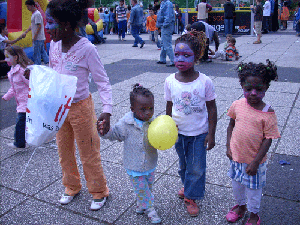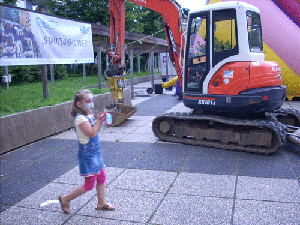Apolonija Sušterši?
Artist in Residence - Bochum-Hustadt
From September 2008 until approximately April 2009, Apolonija Sustersic is Artist in Residence in Bochum. She is working on a project in the Hustadt, a district in Querenburg, Bochum. It is funded by the European Union, Germany, North Rhine-Westphalia, and the city of Bochum, and is part of a wider urban development in the context of the Stadtumbau West. It is initiated by the building society VBW and the city planning office in Bochum. The creative part is in the hands of Apolonija Sustersic and Galerie m in consultation with the association Situation Kunst and the Art Historian Institute of the Bochum University.

Wunder-Kinder

Bagger-Kind

Kids on Slide
The Galerie m has ever since literally touched its local environment by positioning sculptures and installations, and thereby intervened the symbolic common grounds of Ruhr valley inhabitants. Sculptures and installations primarily function through their material being and referencing within urban settings or nature sites.
However, in the cooperation with Apolonija Sustersic, Galerie m extends its traditional way of engagement in the public sphere. The process-based project will unfold a very specific social history of the people and place at stake, rather than satisfying the culture and art touristy gaze. Though it will result in a material artwork, the latter might nevertheless not immediately be identified as such. This is because the art is in that case meant to fulfil concrete functions, such as offering duties and responsibilities to residents in order to proceed and outlast the official time slot of production.
In art theoretical terms, the project opposes those kinds of works that have their ends in themselves. Rather than creating in reference to a certain discourse, the artist serves as a cultural mean of framing space in human manners. In comparison to the modern way of city planning from drawing-boards, the artist uses methods such as qualitative interviewing and ethnographic research, and is as much oriented towards the (re-)creation of the community as she is seeking for attractive aesthetic expression, solid meaning, and adequate political statement.
The Hustadt is a small dwelling place, located like an isle at the edges of Bochum in between woods and fields on the one hand, and offshoots of the enormous campus of the Ruhr University, as well as other housing areas on the other hand. The Hustadt was built in the late 1960s, and mainly consists of 13 level residential buildings on the hill, owned by the house building company VBW, and around 50 smaller family bungalows down in the valley.
The Hustadt was planned for approximately 6.000 inhabitants. Initially, they were either academic professionals from the University, or employees of the automobile company Opel. The place was meant to be a so called Universitätsrahmenstadt - a dwelling area to frame the campus of the Bochum University - with the purpose to offer professors, students, academic and public employees close living possibilities. The high buildings on the hill were meant for blue and white-collar workers, while the bungalows down in the valley were built for academic employees. The idea was to combine different social levels in one dwelling space. It was a very pedagogic project under a strong social democratic ideology.
However, the place has changed. The Hustadt is today home of people from many different countries, most of them young families, or students. Only one professor still lives there. Compared to other poor and socially problematic urban sites, the Hustadt is in quite a good condition, thanks to the engagement of the VBW, and private persons who put a lot of effort into the development of well-working community structures. The VBW is keen to refurbish its buildings and colours them in order to attract people and offer an urban feeling of a comfortable and aesthetically emotive environment.
This is the context wherein Apolonija Sustersic will start to develop her work in order to unfold her creative intervention, which will enable dialogue and solidarity among different cultures and generations.
The main goal is to deal with the pivotal square called Brunnenplatz, which is predestined to become a center for intercultural dialogue and vivid community life.
However, in the cooperation with Apolonija Sustersic, Galerie m extends its traditional way of engagement in the public sphere. The process-based project will unfold a very specific social history of the people and place at stake, rather than satisfying the culture and art touristy gaze. Though it will result in a material artwork, the latter might nevertheless not immediately be identified as such. This is because the art is in that case meant to fulfil concrete functions, such as offering duties and responsibilities to residents in order to proceed and outlast the official time slot of production.
In art theoretical terms, the project opposes those kinds of works that have their ends in themselves. Rather than creating in reference to a certain discourse, the artist serves as a cultural mean of framing space in human manners. In comparison to the modern way of city planning from drawing-boards, the artist uses methods such as qualitative interviewing and ethnographic research, and is as much oriented towards the (re-)creation of the community as she is seeking for attractive aesthetic expression, solid meaning, and adequate political statement.
The Hustadt is a small dwelling place, located like an isle at the edges of Bochum in between woods and fields on the one hand, and offshoots of the enormous campus of the Ruhr University, as well as other housing areas on the other hand. The Hustadt was built in the late 1960s, and mainly consists of 13 level residential buildings on the hill, owned by the house building company VBW, and around 50 smaller family bungalows down in the valley.
The Hustadt was planned for approximately 6.000 inhabitants. Initially, they were either academic professionals from the University, or employees of the automobile company Opel. The place was meant to be a so called Universitätsrahmenstadt - a dwelling area to frame the campus of the Bochum University - with the purpose to offer professors, students, academic and public employees close living possibilities. The high buildings on the hill were meant for blue and white-collar workers, while the bungalows down in the valley were built for academic employees. The idea was to combine different social levels in one dwelling space. It was a very pedagogic project under a strong social democratic ideology.
However, the place has changed. The Hustadt is today home of people from many different countries, most of them young families, or students. Only one professor still lives there. Compared to other poor and socially problematic urban sites, the Hustadt is in quite a good condition, thanks to the engagement of the VBW, and private persons who put a lot of effort into the development of well-working community structures. The VBW is keen to refurbish its buildings and colours them in order to attract people and offer an urban feeling of a comfortable and aesthetically emotive environment.
This is the context wherein Apolonija Sustersic will start to develop her work in order to unfold her creative intervention, which will enable dialogue and solidarity among different cultures and generations.
The main goal is to deal with the pivotal square called Brunnenplatz, which is predestined to become a center for intercultural dialogue and vivid community life.
